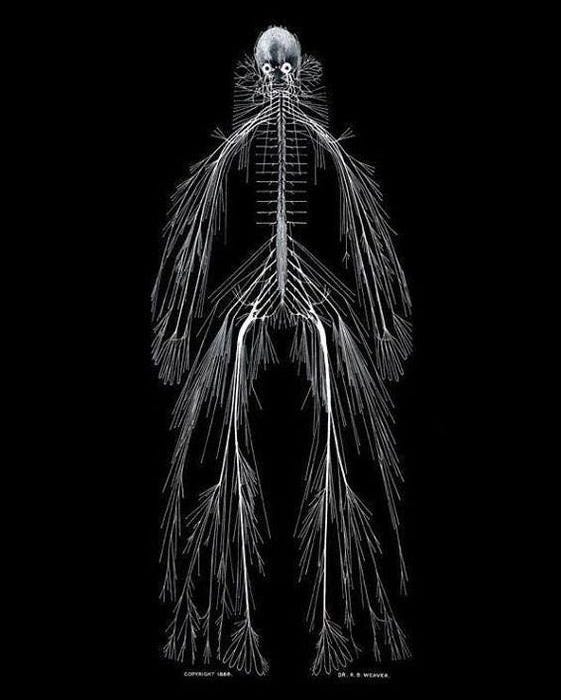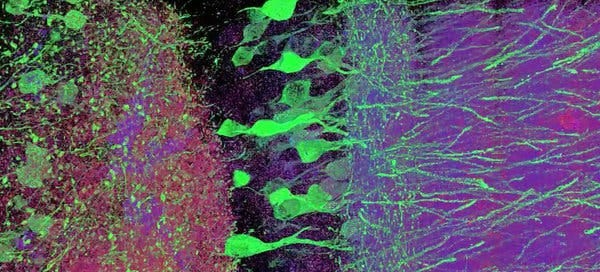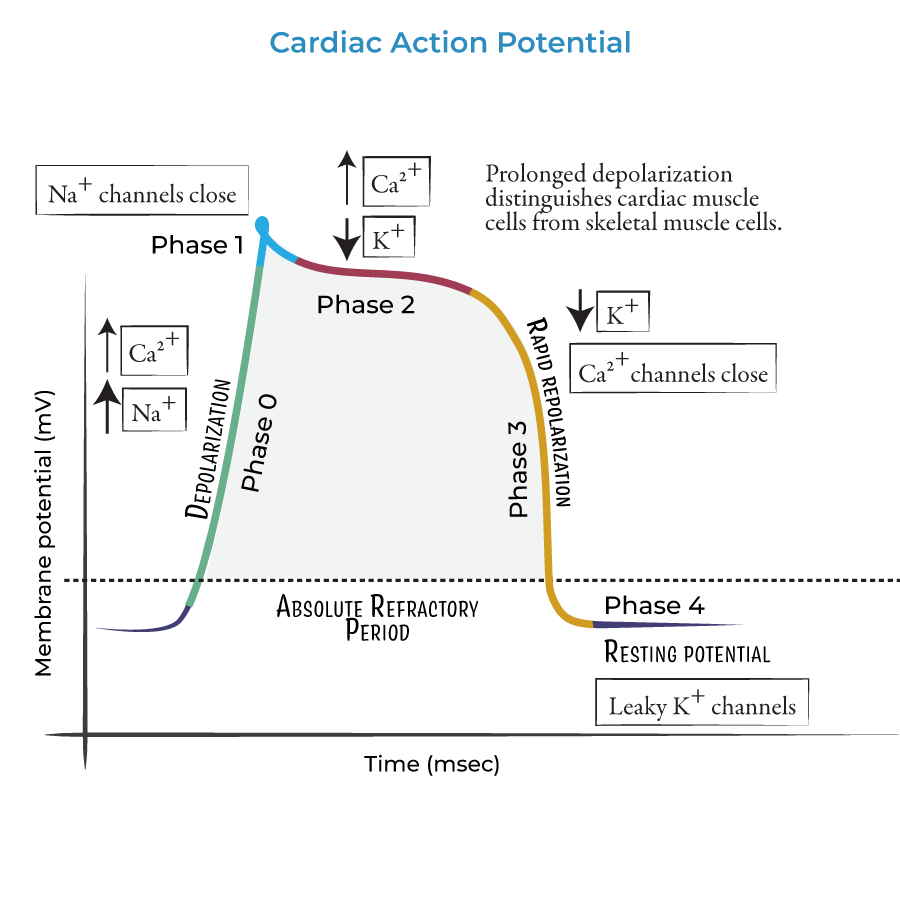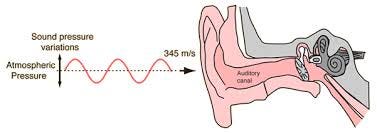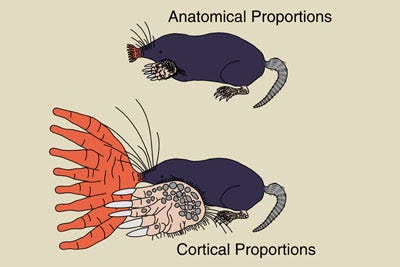The Illusion of Experience: Mind the Gap of Sensory Deception
Why You Have Not Experienced Anything
Our senses, the very tools we rely on to navigate and understand our surroundings, provide us with only a narrow glimpse of reality. From the blind spots in our vision to the limited range of sounds we can hear to the way our brain transforms perceptual information, the world we perceive is astonishingly incomplete.
This post delves into the structure of our nervous system and the profound implications of our sensory limitations, challenging the notion that we have experienced anything close to the full spectrum of reality.
The Structure of the Human Nervous System
The following photo is a real dissection of the nervous system done in the 1880s. Before such dissections, it was not at all self evident to humans that we are a floating system of electrical wires.
Starting at the periphery, there are six special subtypes of neurons: mechanoreceptors, thermoreceptors, nociceptors, chemoreceptors, photoreceptors and proprioceptors.
These specialized receptor neurons have an architecture tuned to capture environmental signals like the electromagnetic radiation of visible light, atmospheric pressure waves of sound and the chemical detection of taste and smell. Some subtypes are temperature and tissue damage indicators. Some inform us where our limbs are in space.
The receiver end of the neuron is called the dendrite, from the Greek “dendron” for tree. The fractal structure of dendrites increases the computational power, network scalability and robustness of the entire system via increased surface area for connectivity.
Histological stain of a mouse neurons using expansion microscopy.
When an environmental signal is detected, neurons exchange electrolytes across their cell wall, forming an electrical voltage for signal propagation.
For example, the neurons in your heart use the sodium, calcium and potassium you consume in food to create this voltage. If you flood the system with an abundance of one electrolyte, such as the potassium chloride used for lethal injections, the heart tissue cannot generate an electrical charge to contract the muscles of the pump.
Neurons fire in an “all or nothing” fashion, meaning the trigger to send a signal is either pulled or not pulled. Since there is no intermediate discharge, it has close parallels to computational systems using binary 0 and 1s. From this emerges computational neuroscience, which uses electrical engineering, computer science and physics to understand how the nervous system processes information.
While not nearly as efficient as an electrical conductor constructed from elemental metals like copper, neurons follow electrical engineering principles such as Ohm's law, capacitance, and thermal insulation. You can see in the dissection photo how nerves thicken near the spinal column to conduct an increasing amount of charge.
To summarize so far, perceptual information from the environment is captured by specialized receptors in our nervous system and transformed into an electrical signal using electrolytes which is sent to our brain.
At the highest level, the primary function of the brain is to make adaptive models of the external and internal environment using interoceptive and exteroceptive information. These models are continuously updated based on the incoming perceptual information stream to make probabilistic adjustments about how to think and behave.
Said another said, the ability to construct a cognitive mental model of a probabilistic future is imagination. Imagination is one of the greatest advantages humans possess.
The triune brain is an older but useful evolutionary theory of brain development. It’s a model that is too reductionist from the standpoint of neuroscience but is practical in related disciplines, like psychology. The idea is that neuroanatomical structures closer to the spinal cord are more evolutionarily ancient while farther exterior structures are more recently developed.
The triune brain is three interacting operating systems.
The autonomic functions and reflexes as well as balance and locomotion nestled in the cerebellum and brainstem. This is the fight or flight basement level reptilian brain shared by most mammals.
The limbic system which colors incoming information with an emotional charge. The psychologists would call this the emotional valence you feel for everything in your environment. It’s like magnetism in that all objects are on a valence spectrum of attractiveness or averseness. You move towards objects with positive valence and retreat from objects with negative valence.
Higher cognitive functions like rational thought come from the highest and most evolutionarily recent neocortical structures. Consider these higher cognitive systems as regulators of the emotional and locomotive systems. A fixture clinical case study in neurology and psychology, railroad worker Finneus Gauge suffered cognitive defects specific to impulse control after an iron rod destroyed much of his left frontal lobe in an 1848 accident.
Next, let’s explore the quantitative limits of our sensory receptors to underscore our limitations in constructing an accurate worldview. Just considering how much of our environment is invisible to our perceptual interface and that sensory receptors optimized for reproductive fitness would be very different then ones optimized for truth or understanding, it seems highly likely that our senses hide a world much deeper and complex then we can imagine.
The Limits of Human Vision
All humans have an optical blind spot where the optic nerve connects to the retina, resulting in an area without photoreceptors. This blind spot is compensated for by the visual cortex, which fills in the missing information from the other eye.
You can find your blindspot using the following picture.
Close one eye and fixate the other eye on the X in the middle. Start approximately 10-12 inches from the screen.
While fixated on the X with one eye closed, move your head forwards and backwards until the dot on the side of your open eye disappears.
Human vision is restricted by the tuning of our photoreceptors to only the spectrum of “visible light,” which ranges from 380 to 750 nanometers. The entire electromagnetic spectrum ranges from gamma rays at less then 0.01 nanometers to longer radio waves thousands of kilometers wide.
The visible light range we detect with our eyes makes up only about 0.0035% of the entire electromagnetic spectrum.
In some cases technology can greatly enhance our perceptual capabilities, for example in night and thermal vision goggles.
The Limits of Human Hearing
Our ear drum is a biological piezoelectric device that converts mechanical energy to an electrical signal that our brain interprets as sound. The mechanical energy arrives in the form of a pressure wave moving through the atmosphere.
Sound frequencies on Earth range from the infrasonic to the ultrasonic. Infrasonic sounds down to 1Hz are used by humans for geological monitoring and by animals like elephants for infrasonic communication. Ultrasonic frequencies up to 1,000,000,000 Hz (1GHz) are used in medical diagnostics and industrial applications as well as animals like bats for navigation.
Human hearing by comparison is confined to a frequency range of 20 Hz to 20,000 Hz. Considering the entire sonic range, humans can only hear .0002% of all sound.
The Limits of Touch, Taste and Smell
Since taste and smell is a function of chemical density and touch is captured by force or temperature rather than electromagnetic wavelengths it’s hard to establish a comparative range that makes sense. However, their limitations are illustrated when compared to other animals. Humans are at least tenfold weaker in these perceptual realms compared other animals.
A cortical homunculus maps the density of sensory specific brain tissue dedicated to interpreting perceptual information in a proportional representation to the external human body.
Said another way, far more more computational power via neuronal density goes into monitoring the feeling in our hands and face then the rest of our body.
Human touch sensitivity can detect indentations as small as 13 nanometers. Compare this to the star-nosed mole, which can detect differences as small as 1-5 nanometers.
The human tongue has about 10,000 taste buds, each capable of detecting the five primary tastes: sweet, sour, salty, bitter and umami. By comparison taste dominant animals like fish can have over 100,000 taste buds covering their entire body.
The human nose can detect a few parts per billion of smell. By comparison dogs can detect a few parts per trillion.
The Time Limits of Experience
It’s interesting to examine the total time afforded by a single human lifespan to collect perceptual information compared to the collective amount of time all humans have experienced.
Think of your life as small box in spacetime contained inside the much larger box of all human experiences over all of human time. In many ways this is the collective unconscious first explored by Jung.
To calculate total personal experience hours, multiply your age by the number of hours in a year. As a 36 year old this comes out to 36 years x (365 days x 24 hours) = 315,360 lifetime hours.
To calculate the total hours of human experience across history involves taking the total hours of the estimated 108 billion people ever born, who lived on average (until recently) 35 years. This comes out to approximately 33,112,800,000,000,000 lifetime hours.
Dividing personal hours by total human hours gives us 0.000000000952%, a sliver of the total human experience.
Why You Have Not Experienced Anything
To summarize, the basic structure of the nervous system is that peripheral receptors convert perceptual information into an electrical signal which allows our brains to continuously update a predictive, probabilistic cognitive model of the world and make adaptive corrections to the model.
It’s like we’re an electrically charged, terrestrial jellyfish navigating an ocean of energetic quantum superposition just trying to live long enough to reproduce.
Said another way, life is the perceptual experience of flashing lights, sounds and experiences that you attach meaning to over time.
It’s evident we perceive only an infinitesimal sliver of the world through our sensory organs and we are not afforded much time to do it. The final step is to multiply your lifetime experience hours by the trickle of sensory information our nervous system can capture to appreciate how little of the world we perceive. For myself at 36 this is approximately 0.000000000000000000006664% or said another way, a rounding error.
Lastly, its important to understand that, not only is our perceptual view into the world like standing in a pitch black room with earplugs in, but very little of that perceptual information makes it to conscious awareness. The value hierarchy by which our brain processes incoming information is tuned for survival and reproduction, only perceiving reality at the minimum level required for its tuning. For example, the informational value of a car barreling down on you while crossing the street takes hierarchical priority over the informational value of noticing a strangely shaped pebble on the asphalt. A hierarchy tuned to the truth of reality would weight information differently and likely rapidly been extinguished by natural selection since reproduction is not whats optimized.
So in the face of this, how can you possibly hold any ideological or dogmatic beliefs?
How can you think you know the best way for society to be structured when you have experienced so little?
How can you possibly think that you know anything at all?
Consider these limitations to counter to the human tendency towards pride and ego. It’s no accident that humility is a virtue in almost all philosophical, religious and ethical systems around the world.
Issac Newton reportedly said the following towards the end of his life:
“I do not know what I may appear to the world, but to myself I seem to have been only like a boy playing on the seashore, and diverting myself now and then finding a smoother pebble or a prettier shell than ordinary, whilst the great ocean of truth lay all undiscovered before me."

